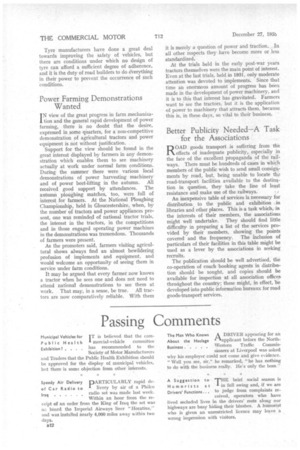Make Slippery Roads Illegal
Page 17

Page 18

If you've noticed an error in this article please click here to report it so we can fix it.
THE prevalence of accidents mainly due to the skidding of motor vehicles has again brought into prominence the vital importance of providing non-skid surfacings for all of our important traffic thoroughfares.
It is a very weak defence for road authorities to have to blame inclement weather for an increase in accidents. It has already been proved that it is comparatively simple and cheap to give the average road satisfactory nonskid characteristics without reducing its wearing life or introducing other deleterious factors. It should be easy to dexise some standard by which the non-skid properties of a road surface in any weather can be judged, and the road authorities of any district where the results prove unsatisfactory should be taken severely to task for their shortcomings. Tyre manufacturers have done a great deal towards improving the safety of vehicles, but there are conditions under which no design of tyre can afford a sufficient degree of adherence, and it is the duty of road builders to do everything in their power to prevent the occurrence of such conditions.
Power Farming Demonstrations Wanted
I N view of the great progress in farm mechaniza tion and the general rapid development of power farming, there is no doubt that the desire, expressed in some quarters, for a non-competitive demonstration of agricultural tractors and power equipment is not without justification.
Support for the view should be found in the great interest displayed by farmers in any demonstration which enables them to see machinery actually at work under normal farm conditions. During the summer there were various local demonstrations of power harvesting machinery and of power beet-lifting in the autumn. All received good support by attendances. The autumn ploughing matches, too, were full of interest for farmers. At the National Ploughing Championship, held in Gloucestershire, when, by the number of tractors and power appliances present, one was reminded of national tractor trials, the interest in the tractors, in the competitions and in those engaged operating power machines in the demonstrations was tremendous. Thousands of farmers were present.
As the promoters said, farmers visiting agricultural shows always find an almost bewildering profusion of implements and equipment. and would welcome an opportunity of seeing them in service under farm conditions.
It may be argued that every farmer now knows a tractor when he sees one and does not need to attend national demonstrations to see them at work. That may, in a sense, be true. All tractors are now comparatively reliable. With them it is merely a question of power and traction. Jn all other respects they have become more or less standardized.
At the trials held in the early post-war years tractors themselves were the main point of interest. Even at the last trials, held in 1931, only moderate attention was devoted to implements. Since that time an enormous amount of progress has been made in the development of power machinery, and it is to this that interest has gravitated. Farmers want tosee the tractors, but it is the application of power to machinery that attracts them, because this is, in these days, so vital to their business.
Better Publicity Needed—A Task for the Associations
ROAD goods transport is suffering from theeffects of inadequate publicity, especially in the face of the excellent propaganda of the railways. There must be hundreds of cases in which members of the public wish to send small consign.; ments by road, but, being unable to locate the road-transport facilities available to the destination in question, they take the line of least resistance and make use of the railways.
An inexpensive table of services is necessary for distribution to the public and exhibition in libraries and other places. This is a task which, in the interests of their members, the associations might well undertake. They should find little difficulty in preparing a list of the services provided by their members, showing the points covered and the frequency. The inclusion of particulars of their facilities in this table might be used as a lever by the associations in seeking recruits.
The publication should be well advertised, the co-operation of coach booking agents in distribution should be sought, and copies should be available for inspection at all association offices, throughout the country; these might, in effect, be developed into public information bureaux for road goods-transport services.












































































